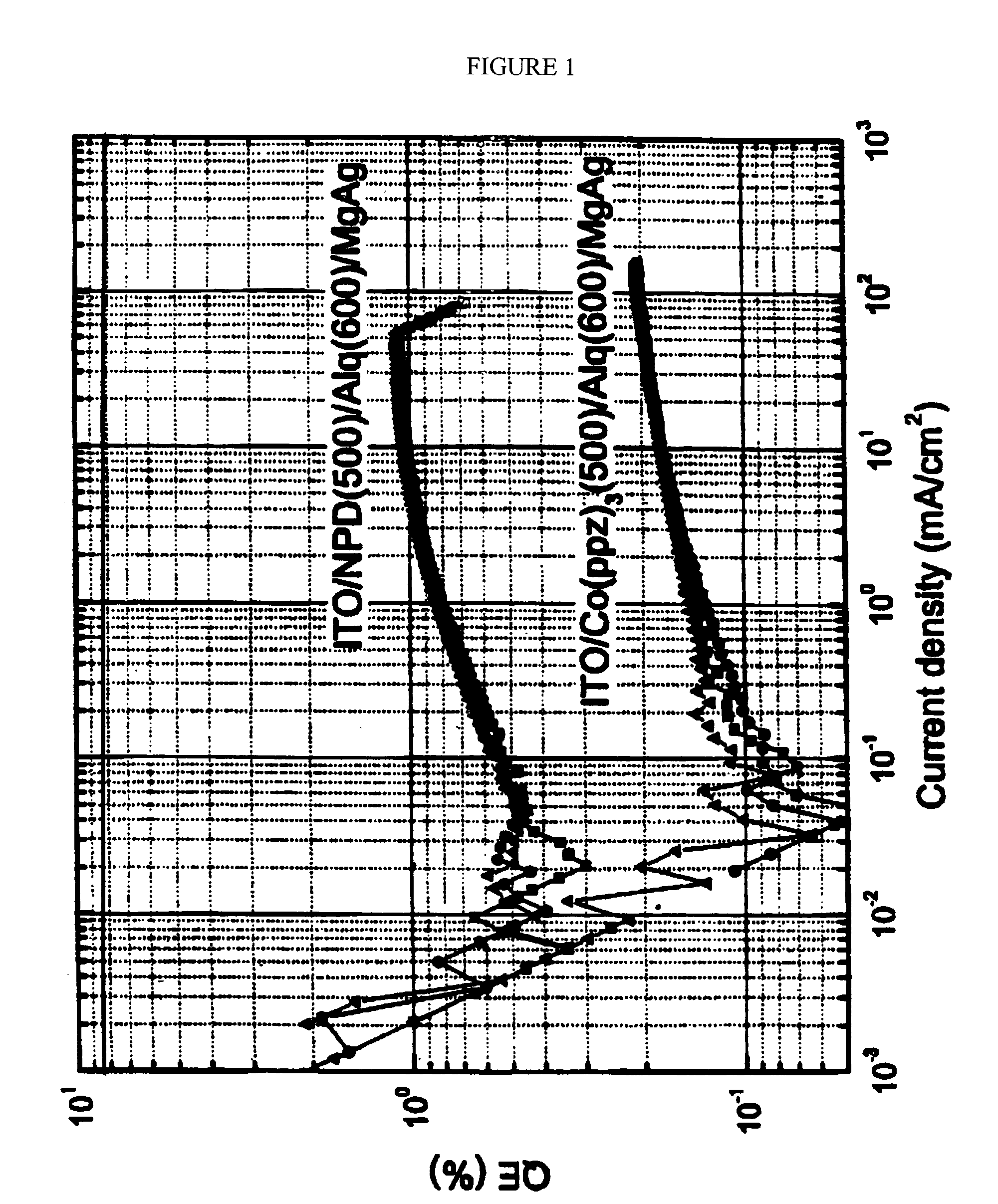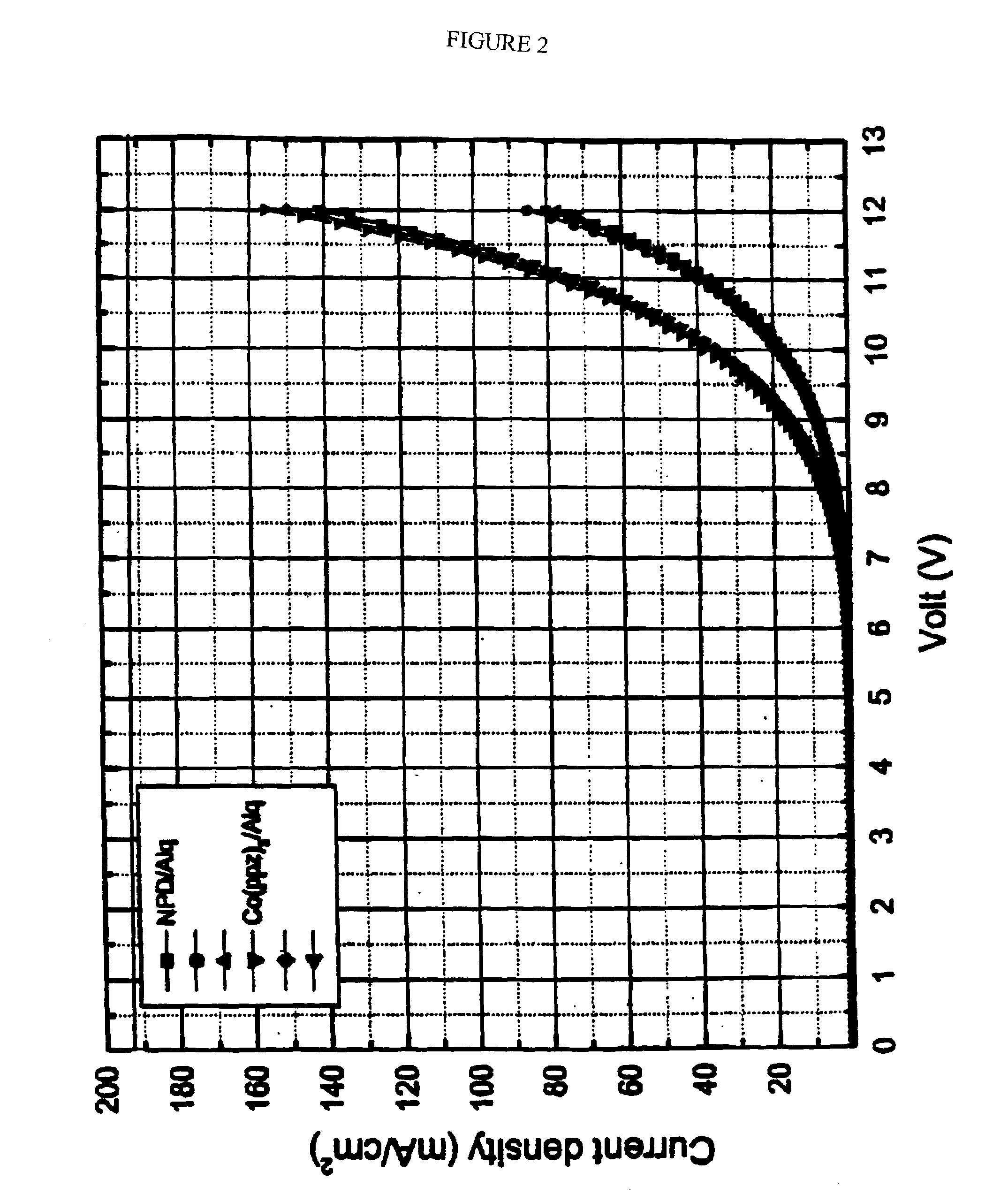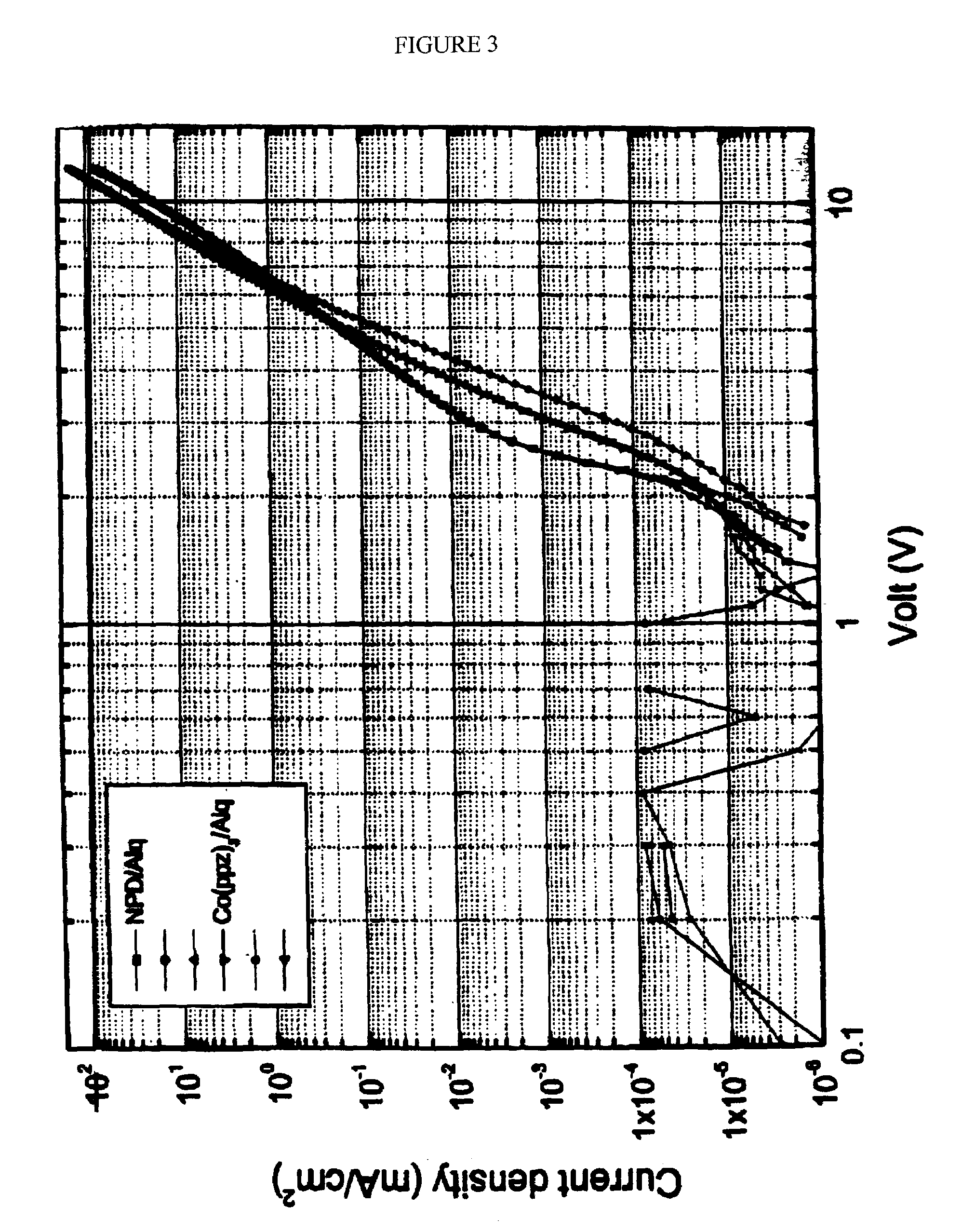Organic light emitting devices having carrier transporting layers comprising metal complexes
a technology of metal complexes and light-emitting devices, which is applied in the direction of organic semiconductor devices, group 3/13 element organic compounds, natural mineral layered products, etc., can solve the problems of short life span, loss of efficiency, and photo-emissive events
- Summary
- Abstract
- Description
- Claims
- Application Information
AI Technical Summary
Benefits of technology
Problems solved by technology
Method used
Image
Examples
example 1
Synthesis of Tris(1-phenylpyrazole-C2,N′) Cobalt (III) (Co(ppz)3)
[0167]To a solution of 1-phenylpyrazole (1.0 equiv. Mol, 6.93 mmol), in THF (3 ml), was added ethylmagnesium bromide (1.1 equiv. Mol, 7.6 mmol). The reaction mixture was refluxed for three hours under argon atmosphere, and then cooled in a dry ice / acetone bath. A solution of cobalt (II) bromide (0.5 equiv mol, 3.47 mmol) in THF (8 ml) was then added slowly to the Grignard. Immediately the reaction mixture turned black. The bath was removed and the mixture was stirred two days.
[0168]The reaction mixture was transferred to a separatory funnel containing aqueous NH4Cl (10 g / liter, 75 ml) and CH2Cl2 (75 ml) and shook. The resulting thick emulsion was passed through a course fritted funnel, which aided the separation of the two layers. The organic layer was isolated and the aqueous layer was extracted twice more with CH2Cl2 (75 ml). The CH2Cl2 solutions were combined, dried over MgSO4, filtered and concentrate under reduced...
example 2
Synthesis of Tris(1-(4-tolylphenyl)pyrazole-C2,N′) Cobalt (III) (CoMPPZ)
[0169]Ligand synthesis (4-tolylphenylpyrazole): A 250 ml flask was charged with a magnetic stirrer bar, 4-tolylboronic acid (16 mmol, 2.0 equiv.), pyrazole (8 mmol, 1.0 equiv.), anhydrous cupric acetate (12 mmol, 1.5 mmol), 6 g activated 4Å molecular sieves, pyridine (16 mmol, 2.0 equiv.), and 96 ml dichloromethane. The reaction was stirred under air at ambient temperature in a loosely capped flask for 2 days. The reaction mixture was filtered through Celite, washed with water and purified by silica gel chromatography (eluent:ethyl acetate:hexane=1:7)
[0170]Complex synthesis: To a solution of 4-tolyllpyrazole (1.0 equiv. Mol, 6.93 mmol), in THF (3 ml), was added ethylmagnesium bromide (1.1 equiv. Mol, 7.6 mmol). The reaction mixture was refluxed for three hours under argon atmosphere, and then cooled in a dry ice / acetone bath. A solution of cobalt (II) bromide (0.5 equiv mol, 3.47 mmol) in THF (8 ml) was then add...
example 3
Synthesis of Tris(1-(4-methoxyphenyl)pyrazole-C2,N′) Cobalt (III) (CoMOPPZ)
[0172]Ligand synthesis (4-methoxyphenylpyrazole): A 250 ml flask was charged with a magnetic stirrer bar, 4-methoxyboronic acid (16 mmol, 2.0 equiv.), pyrazole (8 mmol, 1.0 equiv.), anhydrous cupric acetate (12 mmol, 1.5 mmol), 6 g activated 4 Å molecular sieves, pyridine (16 mmol, 2.0 equiv.), and 96 ml dichloromethane. The reaction was stirred under air at ambient temperature in a loosely capped flask for 2 days. The reaction mixture was filtered through Celite, washed with water and purified by silica gel chromatography (eluent:ethyl acetate:hexane=1:7)
[0173]Complex synthesis: To a solution of 4-methoxypyrazole (1.0 equiv. Mol, 6.93 mmol), in THF (3 ml), was added ethylmagnesium bromide (1.1 equiv. Mol, 7.6 mmol). The reaction mixture was refluxed for three hours under argon atmosphere, and then cooled in a dry ice / acetone bath. A solution of cobalt (II) bromide (0.5 equiv mol, 3.47 mmol) in THF (8 ml) was...
PUM
| Property | Measurement | Unit |
|---|---|---|
| quantum efficiency | aaaaa | aaaaa |
| quantum efficiency | aaaaa | aaaaa |
| orbital energy levels | aaaaa | aaaaa |
Abstract
Description
Claims
Application Information
 Login to View More
Login to View More - R&D
- Intellectual Property
- Life Sciences
- Materials
- Tech Scout
- Unparalleled Data Quality
- Higher Quality Content
- 60% Fewer Hallucinations
Browse by: Latest US Patents, China's latest patents, Technical Efficacy Thesaurus, Application Domain, Technology Topic, Popular Technical Reports.
© 2025 PatSnap. All rights reserved.Legal|Privacy policy|Modern Slavery Act Transparency Statement|Sitemap|About US| Contact US: help@patsnap.com



